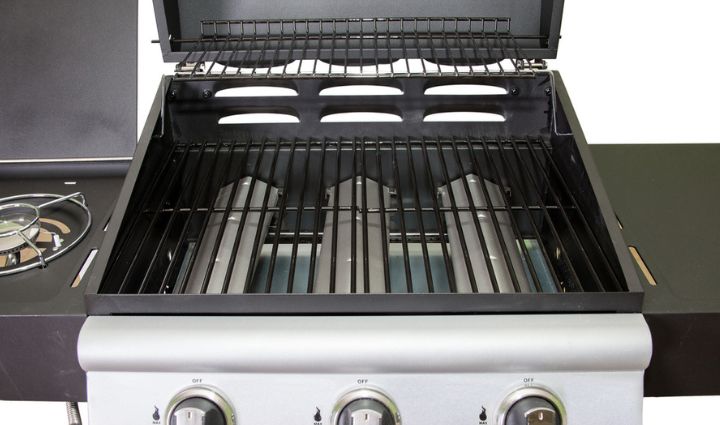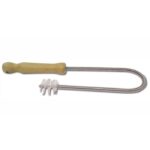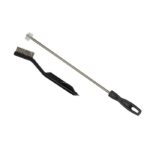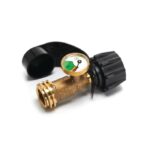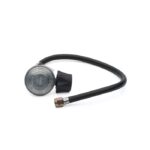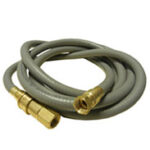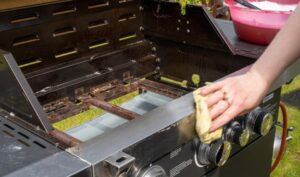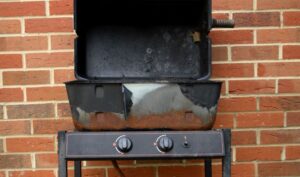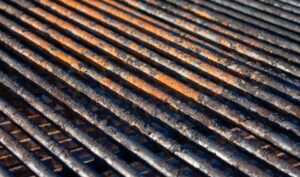The Complete Guide to Troubleshooting Gas Grill Issues is your source for step-by-step instructions on how to diagnose and fix the most common gas grill issues. Whether your grill isn’t heating properly, won’t stay lit, or simply has rusty parts, we’ve got the answers you need to get your gas barbecue firing on all cylinders.
The problem: you fire up your barbecue and discover that only one burner works on your grill. Do you persevere with limited grilling space, or do you call it quits and try again another day?
If only one burner lights on your grill, you may be able to manage with less grilling space if you have a larger grill, or you may not be able to cook anything at all until you get all of the burners working again. Don’t give up yet—in most cases, it’s fairly easy to get your grill back up and running at full strength.
In this section of the Complete Guide to Troubleshooting Gas Grill Issues, we’ll explore 6 of the most common reasons why only one burner on your grill works, such as:
- A clogged burner
- The igniter is not working
- Insufficient fuel levels
- A gas leak
- Your grill is in bypass mode
- A malfunctioning regulator
Thankfully, all of them are relatively easy to fix. Now, let’s get you back to grilling.
6 Reasons Only One Burner On Your Grill Works
1. A clogged burner
If food debris is clogging some or all of the burners or the burners have been knocked out of alignment, this can prevent them from lighting properly. Check your burners for misalignment and obstruction—the burner tube should be properly seated on the gas valve, with the valve sitting inside the opening of the burner.
If there are no problems with alignment, clean the venturi tubes and burner portholes to get rid of any debris that could be limiting gas flow:
- Remove the burners and use a bottle brush or special venturi brush to clean out the venturi tube of each burner.
- Use a wire brush or other needle-like object to remove any deposits from each clogged port and restore normal gas flow.
In the image below, we have outlined several burner blockage scenarios on a typical 3-burner grill with front-to-back tube burner configurations—the most commonly manufactured grill type today. On these types of grills, the gas hose attaches on the left side of the grill. The gas flows from left to right, reaching the right-most burner last.
This chart can help you quickly determine where the blockage is and what the problem and solution might be.
2. Igniter is not working
While most grills have only one igniter, some models are fitted with multiple igniters or individual igniters for each burner. If your grill has more than one igniter, it’s possible that something is malfunctioning with one or more of the electrodes, or the ignition unit itself, resulting in some of the burners not being able to turn on.
To quickly test that the problem is with your igniter, light the burners manually with a match or BBQ lighter. If you are able to light all the burners, it is almost guaranteed to be an ignition issue.
From bad weather and corrosion to dead batteries and loose wires, there are several different reasons why your igniters can stop working properly. Learn more about how to get your igniters firing again in the Gas Grill Won’t Ignite section of the Complete Guide to Troubleshooting Gas Grills Issues.
3. Insufficient fuel levels
If your igniters are working, the carryover tubes are fine, and the burners aren’t clogged, but only one of the burners will light, check if your propane tank is full. To confirm that the fuel gauge is correct place the tank on a weight scale. A standard 20-pound tank will weigh between 37-38 pounds when full. An empty tank will weigh closer to 18 pounds.
Shop for propane gauges:
4. There’s a gas leak
If your fuel levels are fine, a gas leak may be impacting how much fuel your burners are receiving. Gas leaks can be caused by something as small as a loose connection or a damaged gas hose.
To check your grill for gas leaks, follow these easy steps:
- Mix a 50/50 solution of soap and water.
- Brush the solution onto your gas hose and any connection points.
- Open your gas supply. If there are leaks, you will see bubbles forming at the source of the leak.
- Close the gas supply.
If you see bubbles, try to determine where they are coming from:
- If you see bubbles coming from a connection point, disconnect and reconnect your hose. Run the test again. If you still see bubbles, tighten the gas hose and regulator.
- If they are coming from the hose, replace the hose.
Shop for replacement hoses:
5. Your grill is in bypass mode
If only one of your burners is lighting, your barbecue may be in bypass mode. Bypass mode can be triggered by mistake from something as simple as turning on the control knobs before you turn on the gas valve.
What is Bypass Mode? All gas grill regulators are equipped with a safety device called an “Overfill Protection Device” (OPD). This flow-limiting device automatically triggers when it detects a gas leak (or what it perceives to be a gas leak), reducing the gas flow to 10% or less than its standard volume. This prevents the grill from becoming dangerously overfilled with gas.
If you haven’t done so already, perform a gas leak test (see previous section), since that’s the problem this safety device is designed to take care of.
If there are no gas leaks, your next step is to reset the gas grill regulator. Resetting the gas grill regulator OPD is simple. Follow these steps:
- Open the grill lid.
- Turn off the gas to the grill.
- Turn all the control knobs up to high, including any side burners.
- Wait for one full minute, then turn the control knobs off.
- Slowly turn the gas back on.
- Light your grill as normal.
6. A malfunctioning regulator
If the problem isn’t a gas leak or your OPD, your regulator may be malfunctioning. If only one of your burners lights and none of the fixes above have helped, inspect your regulator for cracks and other damage. If you notice that it is damaged, it should be replaced. Thankfully, replacing a regulator is actually fairly straightforward:
- Pick up a new regulator that fits your gas grill.
- Ensure that you have the gas turned off.
- Remove the existing regulator—most simply twist off, but consult your manual if you aren’t sure or are having difficulty.
- Install the new regulator.
- Check for leaks using soapy water.
Conclusion
There could be a few different reasons why only one burner lights on your propane or natural gas grill. Thankfully, all of the potential causes have very easy fixes you can handle at home, such as:
- Cleaning the burners
- Fixing your igniter(s)
- Refilling your tank
- Fixing a gas leak
- Getting your grill out of bypass mode
- Fixing the regulator
Still struggling with your grill? Learn more about different grill problems, what causes them, and how to solve them in our Complete Guide to Troubleshooting Gas Grill Issues.

